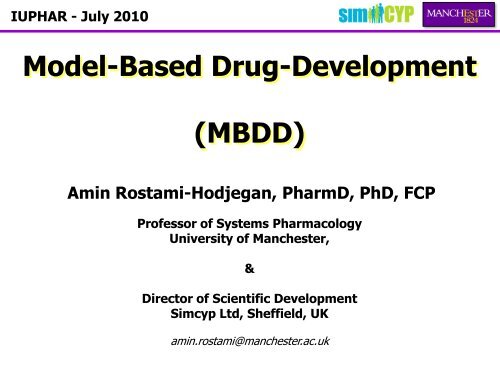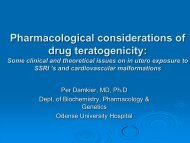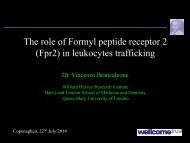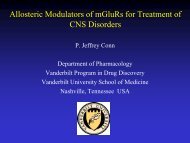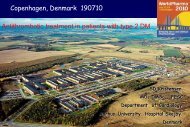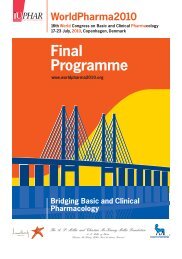Model-Based Drug-Development (MBDD) - WorldPharma 2010
Model-Based Drug-Development (MBDD) - WorldPharma 2010
Model-Based Drug-Development (MBDD) - WorldPharma 2010
You also want an ePaper? Increase the reach of your titles
YUMPU automatically turns print PDFs into web optimized ePapers that Google loves.
<strong>Model</strong>-based <strong>Drug</strong> <strong>Development</strong> (<strong>MBDD</strong>)It should be emphasized that <strong>MBDD</strong> starts before a compound is selectedfor preclinical developmentby defining the PK-PD strategy, biomarkers, and animalstudies that will support translation to humans.The data from each new clinical study must be integrated with relevantprevious information to inform decision-making (e.g., design the nextstudy or terminate the development of the new compound).A common limitation of the current drug development strategy is thatprior information is partly or completely ignored when analyzing andinterpreting the results of the most recent clinical trial.Lalonde et al. 2007, CPT
A Gallery of (PK) <strong>Model</strong>s1C= C i e -kitEmpirical2CompartmentalPhysiologicalComponents:- fully mechanistic- pragmatic/minimalisticGT Tucker (Basic PK Course)
The Need for Systems ApproachClinical Pharmacology & Therapeutics <strong>2010</strong>Inherent in the development of systems clinical pharmacology is a need for modelsthat are physiologically realistic enough to provide accurate systems information yetretain sufficient simplicity to be computationally feasible - in other words, whatVicini [9] describes as “fit-for purpose” models. However, encouraging progresshas been made in predicting individual and even populationpharmacokinetics from models that combine biological systemsinformation with physicochemical drug characteristics [10].
Systems Reference Approach to Success StoryOver 10 years of effort and investment by a large group ofpharmaceutical companies, …… which required a big educational effort although …… there is still a gap between those trained in “old school”and those “new comers”; which needs to be narrowed
Separating Systems & <strong>Drug</strong> InformationSystemsData<strong>Drug</strong>DataTrialDesignMechanisticIVIVE &PBPKPopulation PK (/PD)&Covariates of ADME&Study Design
Creating Virtual Populations.... proposes that new technologies will enable the adoption of virtual R&D; andby operating in a more connected world, the industry in collaboration withresearchers, governments, healthcare payers and providers, can address thechanging needs of society more effectively(Old)Top-Down<strong>Model</strong>lingvsJune 2008(New)Bottom-Up<strong>Model</strong>ling
Building Virtual Man vs PopulationsVirtual Manidentifying relevant typical(representative) values of demographical,biological, physiological and genetic parametersin target populationVirtual Populationidentifying relevant DISTRIBUTION ofvalues for demographical, biological,physiological and genetic parameters in targetpopulation knowing the COVARIATIONSbetween the parameters in target population
In Vitro Systems: e.g. ClearanceHuman Liver Microsomes (HLM)Recombinantly expressed system(rhCYP)HepatocytesFractionation & Isolationof Enriched OrganellesDifferences in intrinsicactivity between rhCYP & HLMIntact cells containing fullcomplement of drugmetabolising enzymesInfrequent supply / costDonor variability
Incidence per 100,000% of controlGFR (ml/min)Albumin (g/L)% of controlPublished Example (<strong>2010</strong>) : Cirrhosis400300Demographics100806040CYPs e.g CYP3A4Cardiac output &Blood Flow2001000Ascites2029.5 39.5 49.5 59.5 69.5Median age (y)0CP-A (6) CP-B (21) CP-C (21)*10080Liver volume6040Gastric emptying160 Renal function12080-150 -100 -50 040shift in gastric emptying T 1/2 in cirrhosis0Control CP-A(112) CP-B(110) CP-C(120)60504030<strong>2010</strong>0200AlbuminCP-A=46 CP-B=53 CP-C=28Control CP-A (94)CP-B (133) CP-C (100)
Preedicted fold increase in exposure (CL ratio)Predicted fold increase in exposure (CL ratio)<strong>Drug</strong>/Route of Administration10CYP1A2CYP2C9CYP2C19CYP2D6CYP3A410Unity2-Fold2-Fold11 10Observed fold increase in exposure (CL ratio)ivOralUnityJohnson et al,Clinical Pharmacokinetics(<strong>2010</strong>)11 Observed fold increase in exposure (CL ratio) 102-Fold2-Fold
Morbid Obesity: BPD-DS & GBPBPD-DS:Bilio-Pancreatic Diversion withDuodenal SwitchGBP:Gastric By-Pass (GBP)
Can We Predict PK in Disease?Yes we can. However, 3 essential elements arerequired for systems and drug independently:1- Data&2- Better Data&3- More Good Data
Is that enough?Sometimes not; hence the 4 th element:Combining Top-Down and Bottom-Up: Middle-OutDVs <strong>Model</strong> DesignParametersParameter Estimation ModulePredictedParameters
OF: Problems with OptimisationF(x)x
Highly Non-Linear Systems: OF250200F(X1, X2)15010050010510X20-5-10-10-50X15
Optimisation Algorithms‣ Direct/random search methods (Hooke-Jeeves, Nelder-Mead, …);‣ Genetic Algorithms (GA);‣ Hybrid Algorithms:Begin with a global optimisation method (GA) and thenswitch to a local optimisation method; e.g., HJ or NM.
Correspondence for full set of slides<strong>Model</strong>-<strong>Based</strong> <strong>Drug</strong>-<strong>Development</strong>(<strong>MBDD</strong>)Amin Rostami-Hodjegan, PharmD, PhD, FCPProfessor of Systems PharmacologyUniversity of Manchester,&Director of Scientific <strong>Development</strong>Simcyp Ltd, Sheffield, UKamin.rostami@manchester.ac.uk


